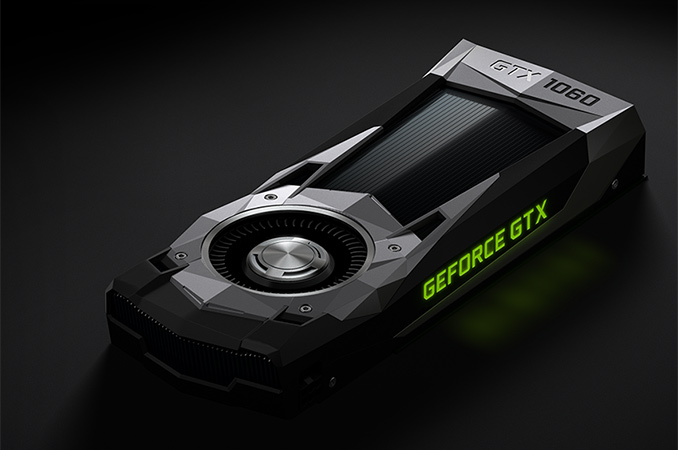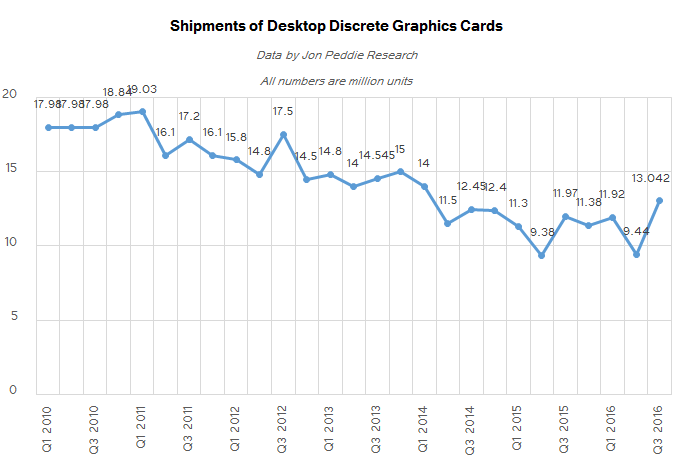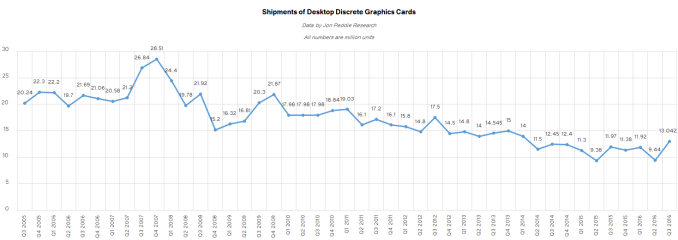Discrete Desktop GPU Market Trends Q3 2016: GPU Shipments Hit Two-Year High
by Anton Shilov on November 28, 2016 9:00 AM EST
Shipments of discrete graphics processing units (GPUs) are traditionally high in the third quarter as PC makers and retailers gear up for the holiday season and build up stocks of components. Q3 2016 was particularly good for standalone GPUs because both AMD and NVIDIA introduced a number of new products for different market segments from May to August. Sales of discrete graphics cards for desktop PCs hit a two-year high in the third quarter, according to data released by Jon Peddie Research. What is important is that standalone GPUs performed very well despite a shrink of PC sales.
Q3 2016: Good for GPUs, Mediocre for PCs
In the third quarter of 2016, the industry sold from 68 million (a 3.9% year-over-year decline, according to IDC) to 68.9 million of PCs (a 5.7% YoY decline according to Gartner). The numbers are up from the second quarter of 2016, but are down from the same period a year ago. A good news is that sales of gaming desktop and notebook PCs are strong, which is why shipments of standalone graphics processors were strong as well. JPR believes that around 34.84% of PCs shipped in Q3 used discrete GPUs. Based on the numbers from IDC and Gartner, we can estimate that this should be between 23.7 and 24.0 million standalone graphics chips were shipped by AMD and NVIDIA in Q3 (assuming that PCs with discrete GPUs had only one discrete card, which is not far from truth as sales of multi-GPU systems are not high in terms of volumes). Nevertheless, keep in mind that data from JPR, IDC and Gartner reflects sold-in numbers - units from distributors rather than end-user sales - which means that not all GPUs ended up in systems already purchased by the end-user.
Fueled by the release of AMD’s Radeon RX family of discrete GPUs for desktops as well as NVIDIA’s launch of its GeForce GTX 10-series line, shipments of graphics cards for desktops increased 38.16% quarter-over-quarter (QoQ) in Q3, according to Jon Peddie Research. JPR does not officially disclose how many graphics adapters for desktop PCs were sold in the third quarter, but based on the company’s previously released numbers, we can estimate that various makers of add-in boards (AIBs) sold approximately 13.04 million video cards, which is up from 11.97 million units in Q3 2015 (see notes below). It is hard to estimate how many standalone GPUs for notebooks were shipped, during the discussed period, but we may be talking about roughly 10 million units.
| Desktop Discrete Graphics Cards Market in Q3 2016 Data calculated from Jon Peddie Research News Numbers are in percentage points or in millions. Numbers are approximate. |
||||||||
| Q3 2016 (current) |
Q2 2016 (previous Q) |
Q3 2015 (previous Y) |
||||||
| Share | Shipments | Share | Shipments | Share | Shipments | |||
| AMD | 29.1% | ~3.80 | 29.9% | ~2.82 | 18.8% | ~2.25 | ||
| NVIDIA | 70.9% | ~9.25 | 70% | ~6.60 | 81.1% | ~9.71 | ||
| Other | 0% | 0 | 0.1% | ~0.0094 | 0% | 0 | ||
| Total | 100% | ~13.04 | 100% | ~9.44 | 100% | ~11.97 | ||
It is evident that Q3 was a good year for desktop graphics cards in general. Moreover, the whole year to date has been positive for AIBs. Various manufacturers have sold a total 34.40 million GPUs in the first three quarters, up 5.35% from a total of 32.65 million in Q1+Q2+Q3 of 2015. Analysts from Jon Peddie Research attribute increases of desktop GPU shipments to new gaming content as well as the promise of virtual reality. Since more new games are about to be released in Q4 and because VR remains a highly discussed topic in the gaming community, it is likely that shipments of desktop discrete GPUs are going to stay at high levels for a while. Nonetheless, it remains to be seen whether their sales in Q4 beat their sales in Q3 (which sometimes happens, especially in cases when supply does not meet demand in Q3).
One of the things to note is the consolidation of the PC market. The three largest PC vendors (Lenovo, HP, Dell) controlled over 58% of the worldwide market in Q3 2016, up from 55% a year ago and 51% in 2014. Such consolidation happens not only because they can negotiate better deals with their suppliers and thus offer better pricing, but also because they are gradually expanding their product families. On the one hand they add mini PCs to their lineups, and on the other they roll-out gaming PCs. For example, this year we observed HP’s return to the market of gaming desktops with the Omen X and ASUS’ release of the ROG GT51 for $4999. Moreover, as markets such as VR are gaining publicity, large PC vendors will try to capitalize on this and offer gaming systems with discrete GPUs. Unfortunately, we have no idea whether this is going to be a long-lasting trend.












53 Comments
View All Comments
RussianSensation - Friday, December 2, 2016 - link
I5 2500K/2600K turn 7 years old next month, since they were released on January 2011!catavalon21 - Sunday, December 11, 2016 - link
How about splitting the difference, and call it 6 years old?Araa - Monday, November 28, 2016 - link
Never been an AMD fan myself but I hope they get out of the slumber they are currently in. I want the good ol' 2010 days back where they were a strong second.Keao - Monday, November 28, 2016 - link
Yeah and back then GPU mid-tier was a bargain :-)Aaaah I miss the days of the RADEON HD4870...
Stuka87 - Monday, November 28, 2016 - link
In 2010 AMD was in first place. Thats back when the 5000 series was king of the hill and the GTX 400 series was delayed 6 months and shipped as a power guzzling pig. It was later on when the updated 500 series brought nVidia back in front as the AMD 6000 series was just a basic re-badge.silverblue - Tuesday, November 29, 2016 - link
Not quite; the 6900 series moved from VLIW5 to VLIW4 due to AMD realising that the average slot utilisation was 3.4, hence there were efficiency gains to be made in reducing the size of each shader block. The 6870 and below were based off the 5000 series, however.just4U - Friday, December 2, 2016 - link
While the 470/80 were guzzlers for sure .. the 460 was the little darling... priced well and gave Nvidia fans something to cheer about. The 500 series certainly brought more to the table, however AMD was matching them in performance while beating them on pricing...I always remember wanting a 560Ti or a 570 but could never justify it on the price so opted for the AMD equivalent... sad to because even as it was about to be discontinued the damn cards never did come down in price. That's when I started to get a little miffed with Nvidia. After the TNT2 They really began to sock it to you price wise with the Geforce line... That's something ATi never really did... even when they were the king of graphics in the early 90s.
Strunf - Thursday, December 8, 2016 - link
ATI/AMD, nVIDIA will charge as much as they can... there are no good guys, they are quoted on the stock market and hence profit driven.In the early 90s the graphics card wasn't so important and there were a few players ATI, S3, Matrox, Intel... then the 3D accelerators kicked in and the market went crazy.
Samus - Tuesday, November 29, 2016 - link
I haven't had an AMD GPU since AMD bought ATI that I liked. They were cheaper, for the same performance as nVidia, but they failed early, the drivers were awful, and their partners were and still are lousy. AMD doesn't have an equivalent OEM builder to nVidia such as PNY or EVGA.And before you laugh about PNY, remember that PNY is actually the largest distributor of nVidia cards. By quite a lot. I remember reading a few years ago that PNY shipped more cards than every other nVidia partner COMBINED. All those Quadro's have helped their bottom line as well.
peterfares - Wednesday, November 30, 2016 - link
ASUS makes AMD cards. They're reputable.